December 11, 2010, 20:59:00 GMT
permalink Post: 6116631
I think he said that the adjacent engine had surged and a piece of ramp went out the front and down the other engine. This resulted in a double engine failure mid atlantic. They landed in Shannon with very little fuel left.
First time that happened was on prototype 001 in the very early days, when an engine "spit out" the entire ramp (there's a photo in Trubshaw's book).
The ramps and actuators were 'beefed up' considerably afterwards... I didn't know an in-service aircraft had suffered a similar mishap.
CJ
PS I have no record of any of the British development aircraft ever having lost a ramp, notwithstanding the number of deliberate engine surges they went hrough. But then maybe I wasn't told....

Subjects
British Airways
Engine Failure
Engine surge
Intakes
Shannon
Links are to this post in the relevant subject page so that this post can be seen in context.
Reply to this quoting this original post. You need to be logged in. Not available on closed threads.
December 14, 2010, 21:57:00 GMT
permalink Post: 6122266
And yes, Concorde evokes images like no other aircraft really does.
Funnily enough, to me the image you describe always evokes something totally different... although it does depend on the exact angle it's taken from.
Seen from exactly the right angle, she has this slight 'smile' on her face, saying "did it again, people... home soon ! ".
Otherwise, oh yes, I have two images.... both sad.
One is the air-to-air video of the Jubilee flypast with the Red Arrows (I don't have the link at hand), when she pulls up and away, saying goodbye.
For some reson, I have never been able to watch that one without a huge lump in my throat.
The other one is this one....
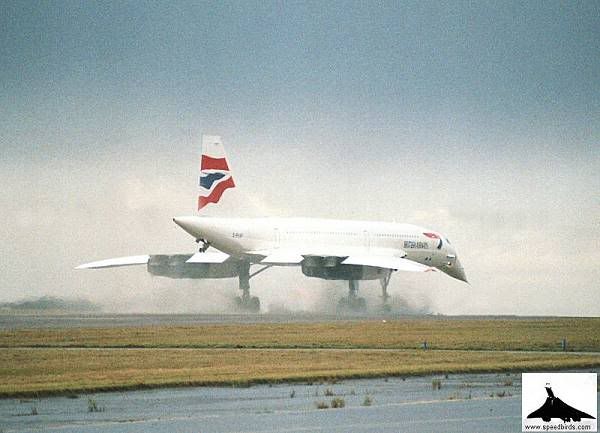
Last time ever.... and somehow one hoped an instant she would disappear from view, and return forever to the sky where she belonged.
And why should I now be furiously rubbing my eyes?
But maybe that answers your question, too....
Christian
Subjects: None
No recorded likes for this post (could be before pprune supported 'likes').Reply to this quoting this original post. You need to be logged in. Not available on closed threads.
December 15, 2010, 14:57:00 GMT
permalink Post: 6123526
A more cheerful image !
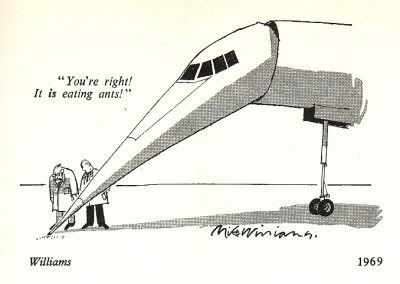
CJ
Subjects: None
No recorded likes for this post (could be before pprune supported 'likes').Reply to this quoting this original post. You need to be logged in. Not available on closed threads.
December 16, 2010, 15:13:00 GMT
permalink Post: 6125696
If you haven't got it already, try and get a copy of Brian Calvert's "Flying Concorde", which has the story of those first landings and take-offs in New York in some considerable detail.
CJ
Subjects: None
No recorded likes for this post (could be before pprune supported 'likes').Reply to this quoting this original post. You need to be logged in. Not available on closed threads.
December 17, 2010, 20:53:00 GMT
permalink Post: 6128325
Concorde Books .
Probably too late for Christmas, but maybe useful just the same.
CJ
Subjects: None
No recorded likes for this post (could be before pprune supported 'likes').Reply to this quoting this original post. You need to be logged in. Not available on closed threads.
December 18, 2010, 15:46:00 GMT
permalink Post: 6129580
That just went into my 'archive'.
Maybe it should be printed out, plastified, and used as a briefing sheet for the Brooklands simulator, where the JFK 31L take-off is still one of the favourites !
CJ
Subjects
Brooklands
JFK
Simulator
Links are to this post in the relevant subject page so that this post can be seen in context.
Reply to this quoting this original post. You need to be logged in. Not available on closed threads.
December 19, 2010, 00:44:00 GMT
permalink Post: 6130444
You'll have everybody here green with envy....
Even if it was on a "blunty" it was still spectacular.
And I think Kai Tak is already in the Brooklands sim database.... so you can now come and fly it yourself....
CJ
Subjects
Brooklands
Haynes guide to Concorde
JFK
LHR-JFK Route
Links are to this post in the relevant subject page so that this post can be seen in context.
Reply to this quoting this original post. You need to be logged in. Not available on closed threads.
December 19, 2010, 18:28:00 GMT
permalink Post: 6131754
See you again sometime after Xmas, when you've worked your way through the 45 pages this thread has already generated......
Subjects: None
No recorded likes for this post (could be before pprune supported 'likes').Reply to this quoting this original post. You need to be logged in. Not available on closed threads.
December 19, 2010, 18:50:00 GMT
permalink Post: 6131791
Re the autotrim, tell us some more?
I wasn't directly involved with the control laws themselves, more with trying to assure those control laws were respected to well below 1%.
Still, I think you'll agree that lessons were learnt, rather than totally ignored.
I would say Airbus can trace its history back to the lessons learned from Concorde.
CJ
Subjects
Airbus
Auto-trim
FBW (Fly By Wire)
Links are to this post in the relevant subject page so that this post can be seen in context.
Reply to this quoting this original post. You need to be logged in. Not available on closed threads.
December 20, 2010, 16:01:00 GMT
permalink Post: 6133611
Either replace that last " 1 " with a " 0 " or just delete the "1", then press enter.
CJ
Subjects: None
No recorded likes for this post (could be before pprune supported 'likes').Reply to this quoting this original post. You need to be logged in. Not available on closed threads.
December 21, 2010, 14:47:00 GMT
permalink Post: 6135595
CJ
Subjects: None
No recorded likes for this post (could be before pprune supported 'likes').Reply to this quoting this original post. You need to be logged in. Not available on closed threads.
December 21, 2010, 18:47:00 GMT
permalink Post: 6136007
CJ
Subjects: None
No recorded likes for this post (could be before pprune supported 'likes').Reply to this quoting this original post. You need to be logged in. Not available on closed threads.
December 21, 2010, 20:20:00 GMT
permalink Post: 6136200
The Mach trim control law
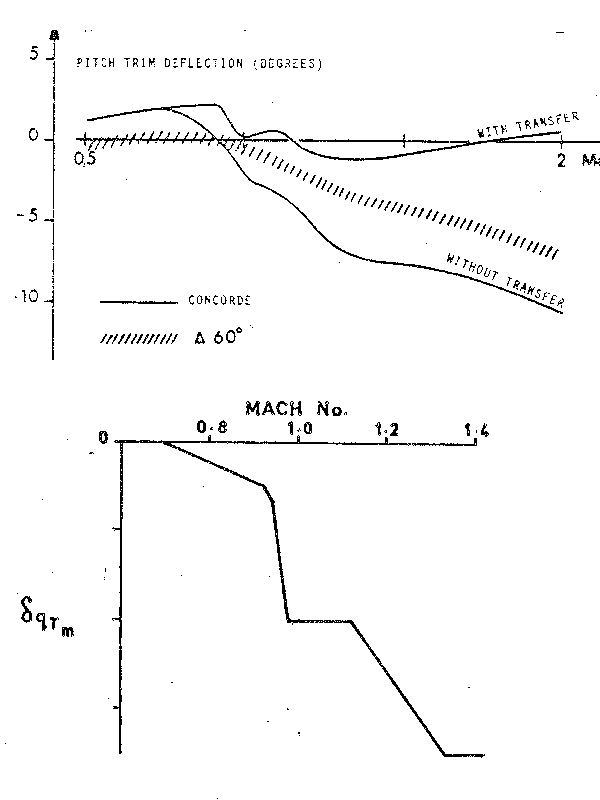
The aircraft response to a double engine surge
Split into two halves (longitudinal and lateral response)
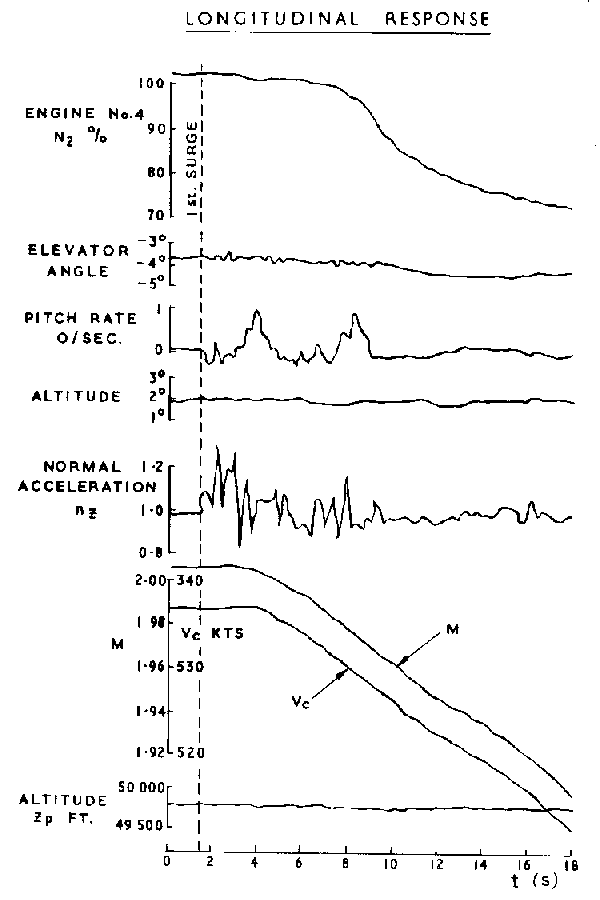
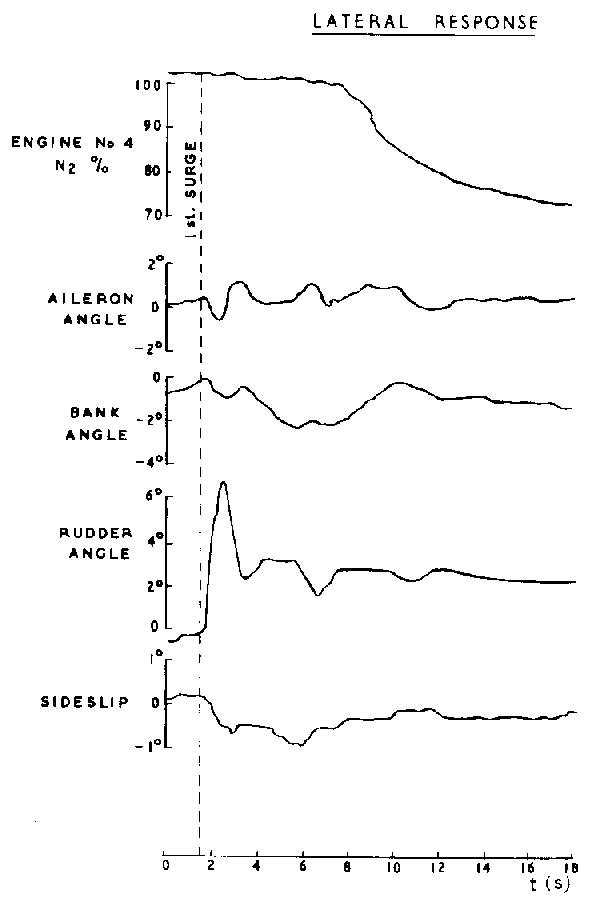
Note the almost immediate rudder response, long before the engine N2 rpm starts to wind down. I'll have something to say about that in a separate post....
CJ
Subjects
Engine surge
Mach Trim
Rudder
Trim
Links are to this post in the relevant subject page so that this post can be seen in context.
Reply to this quoting this original post. You need to be logged in. Not available on closed threads.
December 21, 2010, 21:00:00 GMT
permalink Post: 6136266
The designers were, right from the start, aware of this problem.
Hence, the prototypes were equipped with specific "contre automatique" (auto-rudder) computers, that would "kick in" a given rudder deflection as soon as they detected an engine failure (and twice as much in the case of a double failure).
Unfortunately... the manner of detecting an engine failure was based on pressure sensors in the engine, which proved to be notoriously unreliable.
Since the whole system was "fail-passive", in the case of a pressure sensor failure nothing happened, other than that I got the "suspect" computer dumped in my lap every time, since it was easier to swap a computer than test and swap pressure sensors....
In the end, it was always "no fault found", and the engineers had to go and test the sensors to find the failed one.
Already on the pre-production aircraft, this Rube Goldberg system was replaced by a single circuit board 'buried' in the autostab computer.
It used a lateral accelerometer to detect the abrupt yaw of a sudden engine failure or surge, and applied appropriate rudder. Look at the sudden rudder deflection 'peak' on the lateral response graph in the previous post.
Since there was no separate 'auto-rudder engage' control switch (the function was permanently active), and it was only mentioned very much in passing during training, some pilots were not even aware it existed.......
CJ
Subjects
Auto-stabilisation
Engine Failure
Engine surge
Rudder
Links are to this post in the relevant subject page so that this post can be seen in context.
Reply to this quoting this original post. You need to be logged in. Not available on closed threads.
December 22, 2010, 14:50:00 GMT
permalink Post: 6137600
Pilot demands in manual flight produced electrical signals corresponding to the control position, which were sent to the 'servo control amplifiers' (eight in all, one per control surface) which in turn commanded the PFCUs (power flying control units) that hydraulically moved the control surfaces.
Autopilot demands directly moved the pilot's controls (stick and rudder) via hydraulic cylinders (the 'relay jacks') so that the same signals as in manual flight then went to the servo control amplifiers.
The purpose of the autostab was to provide proper dynamic stability over the full flight envelope. The aircraft could be flown without autostab, but over some of the speed range it was only marginally stable.
The electrical signals from the autostab computing were fed directly into the servo control amplifiers, so there was no feedback to the pilot's controls, unlike the autopilot demands.
There was occasional confusion about exactly what did what and how and where.... because the servo control amplifiers - although a function independent of the autostab as such - were housed... in the autostab computers.
To complete the tale, this is what those servo control amplifiers look like.
The one of the left is from prototype 002, the one on the right from a production aircraft. To give them scale, the one on the right is about the size of a box of large kitchen/fireplace matches.
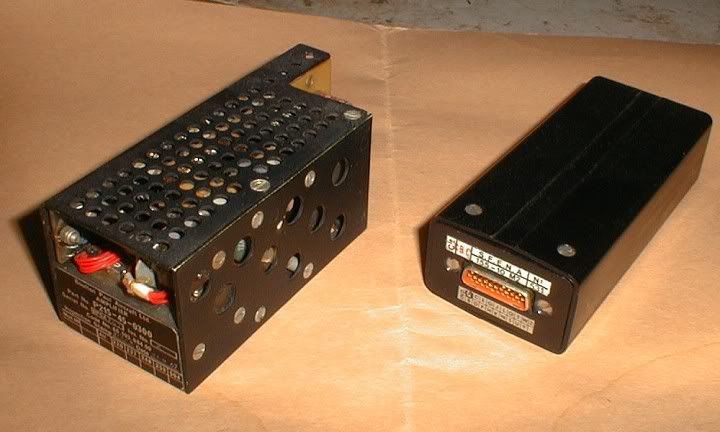
CJ
Subjects
Auto-pilot
Auto-stabilisation
Flight Envelope
Hydraulic
Rudder
Links are to this post in the relevant subject page so that this post can be seen in context.
Reply to this quoting this original post. You need to be logged in. Not available on closed threads.
December 22, 2010, 15:16:00 GMT
permalink Post: 6137656
That reminds me.....
We spent a lot of time, and did a lot of flights, to get the VOR (capture and hold) autopilot mode to work satisfactorily.
It was not until years later, and on another type, that a pilot told me "VOR mode? We never use it. We use TRK or HDG mode, and monitor on the HSI that we're on the VOR radial."
IIRC, in service it was the same on Concorde, but maybe EXWOK or one of the other pilots here can confirm it?
CJ
Subjects
Auto-pilot
Links are to this post in the relevant subject page so that this post can be seen in context.
Reply to this quoting this original post. You need to be logged in. Not available on closed threads.
December 22, 2010, 18:01:00 GMT
permalink Post: 6138001
CJ
Subjects: None
No recorded likes for this post (could be before pprune supported 'likes').Reply to this quoting this original post. You need to be logged in. Not available on closed threads.
December 22, 2010, 20:40:00 GMT
permalink Post: 6138255
Closed loop
As an example, let's look (very simplified) at how the autopilot maintains a selected altitude.
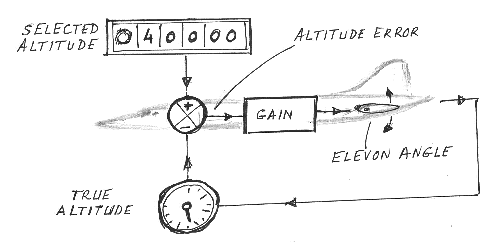
On the one hand we have the desired altitude as selected on the autopilot controller (here 40,000 ft).
On the other hand we have the true altitude , as measured by the altimeter (let's say 39,000 ft).
We subtract the two to obtain the altitude error (in this case 39,000-40,000=-1,000 ft).
We 'multiply' the altitude error by a factor, the gain (for the discussion, let's assume this gain is 1 degree elevon per 1000 ft altitude error), and send the resulting elevon position command to the elevon.
So, the elevon moves 1\xb0 nose-up, the aircraft starts to climb, the altitude increases and the altitude error decreases until it becomes zero, by which time the elevon position has also returned to zero.
What we have now is a "closed loop" : any deviation from the selected altitude results in an elevon command in the opposite direction, until the deviation is again reduced to zero.
Another commonly used term is "feedback" : any error is fed back in the opposite sense until it's reduced to zero.
The significant figure here is the 'gain'.
If the gain is too small, the autopilot response to a disturbance (say turbulence) will be sluggish ; the aircraft takes too long to return to the desired altitude.
If the gain is too high, a small disturbance will cause the aircraft to start climbing too rapidly, and to overshoot the desired altitude, then descend to correct the new error, etc.
In other terms, the control loop is no longer stable, but starts to oscillate.
Both theory and practice show that the exact value of the gain is not all that critical, a few percent more or less do not markedly change the response of the loop.
Note: a "closed control loop" as described above can be implemented in just about any way you like.
It can be done purely mechanically, with a few clever clockwork mechanisms 'computing' the altitude error and controlling the elevator pneumatically or hydraulically. It's how the earliest autopilots worked.
After that came electromechanical systems, analogue computers and then digital computers... but the principle has remained unchanged.
Open loop
As already described in earlier posts, the situation with the automatic trim is the opposite.
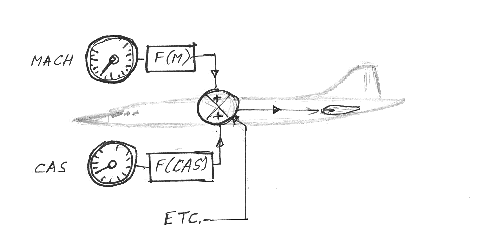
We now need to compute a neutral elevon position from several data, such as Mach number or airspeed, but without any feedback as to whether our computations are correct.
We're now working in "open loop".
To complicate matters... that neutral elevon position is not a simple linear function of Mach and airspeed, but far more complex (see the earlier posted graphs).
And because of the large response of the aircraft to small changes in trim, in particular in the transonic regions, those computations have to be far more accurate : a one degree error is simply not acceptable.
In the end.....
The AICS (air intake control system) also uses several "open loop" functions.
The early development aircraft still had an analogue system, which proved all too soon to be inadequate, so, at a very late stage, it was replaced by a digital system (one of the rare digital systems on Concorde).
The "open loop" functions of the autotrim system initially had the typical "a few" percent" accuracy of the other flight control systems, which, for the autotrim, also proved inadequate.
We managed to "save the furniture" (as they say in French) by using 0.1% components in all the critical computing paths, so the autotrim computers remained analogue until the end.
But, a slide rule is not accurate to 0.1%... So that's when I had to buy my very first pocket calculator.
\xa342 at 1972 prices... just as well the firm paid.
CJ
Subjects
AICS (Air Intake Control System)
Auto-pilot
Auto-trim
Elevons
Intakes
Trim
Links are to this post in the relevant subject page so that this post can be seen in context.
Reply to this quoting this original post. You need to be logged in. Not available on closed threads.
December 23, 2010, 12:08:00 GMT
permalink Post: 6139312
Shortly before the French end-of-service, a small group of French enthusiasts set out in a boat (fishing boat I think) to waypoint 'TESGO' in the Channel, to hear and capture the supersonic bang one more time (TESGO is already beyond the supersonic accel point).
They brought back a video which has become a classic, with both Concorde and a contrail overhead and a recording of the supersonic bang.
A quick search on the net for "TESGO" or "Operation TESGO" didn't produce anything, but I will make some enquiries.
CJ
Subjects: None
No recorded likes for this post (could be before pprune supported 'likes').Reply to this quoting this original post. You need to be logged in. Not available on closed threads.
December 23, 2010, 14:48:00 GMT
permalink Post: 6139560
Those are the essential 30 seconds from a longer video that tells some more about the preparation, etc.
CJ
Subjects: None
No recorded likes for this post (could be before pprune supported 'likes').Reply to this quoting this original post. You need to be logged in. Not available on closed threads.